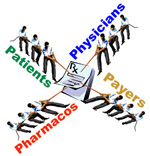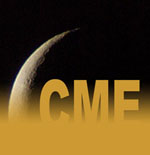Vol. 8, Issue No. 7: AUGUST 2009 – EXECUTIVE SUMMARYSocial Media & the Truncated News Pyramid Upfront Commentary
 PR people are used to issuing press releases to a few journalists at the top of the traditional news pyramid. When the top was blown off by the social media revolution, these professionals had no proven mechanism by which to reach the many thousands of bloggers at the BOTTOM of the pyramid — until now.
PR people are used to issuing press releases to a few journalists at the top of the traditional news pyramid. When the top was blown off by the social media revolution, these professionals had no proven mechanism by which to reach the many thousands of bloggers at the BOTTOM of the pyramid — until now.
Read this entire OpEd piece by John Mack here:
www.news.pharma-mkting.com/PMNews_87_UpFront.pdf Owning the Prescription Pad Driving Brand Decisions in a Multi-Influence World
 The security of a controlled environment for pharma marketing communication is giving way to the complexities of a dynamic environment with more empowered players, including patients who have more influence than ever before over which products make it to market and which are prescribed.
The security of a controlled environment for pharma marketing communication is giving way to the complexities of a dynamic environment with more empowered players, including patients who have more influence than ever before over which products make it to market and which are prescribed.
“Brands face dynamic environments with many influencers,” said Jonathan Kay,Global Practice Head, Brand and Communications at TNS Healthcare, A Kantar Health Company. “Brand managers need to observe, gauge and seek to influence those influencers. Therefore, we need a new model that helps us make sense of a complex world of communications.”This article summarizes that model as presented at a recent TNS/Sudler & Hennessey webinar.
Topic headings include:
- Rethinking Communications in the Digital Age
- World of Influence 3.0
- Identifying the Influence Drivers
- Diversity and Complexity of Influencers
- The Influencers That Matter Most to Physicians
- The Power of Peer Influence
- The Influence of Sales Representatives
- Social Media: Increasing Access to Information
- Mapping the Health Influence Ecosystem
- Online Social Networks Add to the Complexity
- Who or What Drives the Prescription?
- Health Influence Ecosystem Map
Read this article now. It’s FREE…
Social Communications in Healthcare Summary of Roundtable Discussions
 At the Social Communications in Healthcare conference hosted by the Business Development Institute in NYC on July 23, 2009, there were so many people live Tweeting the case study presentations that it’s hardly worth the effort to summarize these presentations after the fact. You can find a good summary–if only in dozens of 140-character packets–on Twitter-.
At the Social Communications in Healthcare conference hosted by the Business Development Institute in NYC on July 23, 2009, there were so many people live Tweeting the case study presentations that it’s hardly worth the effort to summarize these presentations after the fact. You can find a good summary–if only in dozens of 140-character packets–on Twitter-.
An excellent gauge of the state of social communications in healthcare may be had from summaries of the round table discussions moderated by experts after the case study presentations. After a short introduction, this article provides several summaries written by the roundtable discussion leaders themselves.
Topic headings include:
- Pfizer and GSK Take Baby Steps
- Avoiding the Pitfalls of Social Media
- Bringing Legal into Health Care Social Media Strategic Planning
- Fueling Social Networking with Email Marketing
- Social Media and Pharma: Is there a “Right” way?
- Getting Clinician’s Involved in Social Media and Networking Efforts
- Dr. iPhone
- How to Anticipate & Manage the Tough Conversations
- Building a Social Networking Site for BioProfessionals
- Powering Word-Of-Mouth With Social Communications
Read this article now. It’s FREE…
Waning Pharma Support of CME The Plight of For-Profit MECCs Recent headlines pulled from traditional media as well as from the blogo-sphere paint a bleak picture of the future of commercial support for continuing medical education (CME). Is the pharmaceutical industry getting out of the business of supporting CME?
Recent headlines pulled from traditional media as well as from the blogo-sphere paint a bleak picture of the future of commercial support for continuing medical education (CME). Is the pharmaceutical industry getting out of the business of supporting CME?
This article reviews trends in pharma CME support and critiques of that support. The article begins with a review of recent data from ACCME, which indicates that there is a shift in pharma CME funding from MECCs to physician societies. Then, a synopsis is presented of the July 29, 2009, United States Senate Special Committee on Aging hearing on “Medical Research and Education: Higher Learning or Higher Earning?,” which featured testimony from experts who were supportive and critical regarding the benefits of industry-sponsored support of CME. Lastly, the article presents new data from the “What’s the Best Way for Pharma to Support CME?” survey, which asked respondents opinions about several alternative ways for pharmaceutical companies to continue to support CME without drawing the ire of Congress and other critics
Topic headings include:
- The Plight of For-Profit MECCs
- Advertising and Exhibits at CME Events
- Senate Hearing Focuses on CME
- Nissen: ACCME Needs to Go Away
- Kopelow: ACCME Has Made Improvements
- Stossel Offers Anecdotal Evidence
- What’s the Alternative?
- Is Single-Sponsored CME Biased?
- What About Alternative Funding Sources?
- The Pfizer Solution
Read this article now. It’s FREE…



![6 Digital Tools at the Center of Healthcare Digitalization [INFOGRAPHIC]](http://ec2-54-175-84-28.compute-1.amazonaws.com/pharma-mkting.com/wp-content/uploads/2021/04/6DigitalTools_600px-218x150.jpg)




![6 Digital Tools at the Center of Healthcare Digitalization [INFOGRAPHIC]](http://ec2-54-175-84-28.compute-1.amazonaws.com/pharma-mkting.com/wp-content/uploads/2021/04/6DigitalTools_600px-100x70.jpg)




